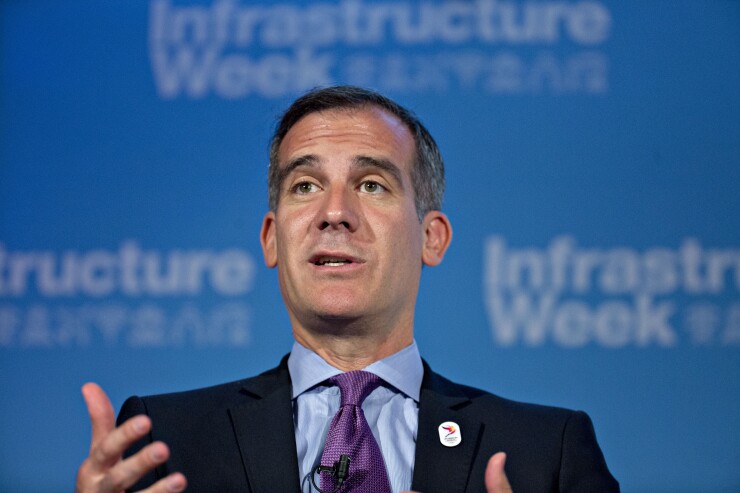Complexities such as layout and a spread-out city center pose a special challenge should Los Angeles adopt congestion pricing, according to Mayor Eric Garcetti.
“Los Angeles is a very complicated topography. It does not have a city center. It’s not like a London or many other places,” Garcetti said at Friday’s annual summit of think tank Regional Plan Association in New York. “We have many city centers, so we’re looking at everything from lanes to vehicle miles traveled.”

New York State earlier this month passed a congestion pricing plan for Manhattan’s central business district, scheduled to take effect in 2021. State and city officials are ironing out the details. Los Angeles and other cities nationwide, including San Francisco and Philadelphia, are weighing the concept.
A
(Audio:
SCAG is proposing pilot “Go Zones” on the Westside of Los Angeles to analyze the effectiveness of congestion pricing, enhanced pedestrian infrastructure and improved transit options.
The mayor sits on the Los Angeles Metropolitan Transportation Authority’s board of directors, rotating as chairman. Garcetti is in his second term.
His big push with LA Metro has been to accelerate mass transit projects before the 2028 Summer Olympic Games, the so-called 28-by-28 initiative. The transit system, meanwhile, has been losing riders to Lyft and Uber over the past five years — a challenge as well for other cities, including New York.
Speaking to a lunchtime gathering of roughly 1,000 business, transit and public finance officials at the Grand Hyatt hotel above Grand Central Terminal, Garcetti said building a regional coalition is vital.
In 2016, 72% of voters approved a Garcetti-backed Measure M, a package of new taxes that could yield $120 billion over 40 years for new rail, bus and bike-lane projects. They could fix many gaps with new rail corridors and better connections, according to Christof Spieler, an engineer and author of the book "Trains, Buses, People."
"L.A. could be one of the great transit success stories of the next few decades," said Spieler, a former Houston Metro board member. "The density is there to support high ridership, and the relentlessly congested freeways make transit attractive."
While Garcetti authored the LA Metro board's motion calling for its own congestion pricing study, to be completed within two years, he said it is no panacea.
“Even in London, it’s gone backwards,” he said. “They saw maybe 10% [fewer] vehicles, but it’s been mostly about raising money for government. And not all of that has gone back into transportation or traffic. So this cannot be [just] a new way that governments fund themselves.
“But I think the more expansive conversation — and it’s a really exciting moment — is we are charging for public space.”
Transit regionalism in Los Angeles County is more manageable than in New York, said Howard Cure, director of municipal bond research for Evercore Wealth Management.
“While you can do it in Los Angeles, with such a vast county that manages buses, light rail and highway construction, the problem in New York generally is that you have more than one state,” Cure said. “So you know that does not always tend to be the most efficient way.
“You have the Port Authority and you also have the MTA and New Jersey Transit. And with the Port Authority there always seems to be a tradeoff, especially with the airports. If you do something with Kennedy, do you have to do something at Newark or direct money at PATH [Port Authority Trans-Hudson commuter rail]?”
Garcetti cited a mass-transit in human terms that resonated with many Angelenos and helped secure Measure M approval.
He cited a television ad that generated a spike in the polls before the ballot measure. It showed Garcetti sitting behind the wheel, stuck in quintessential traffic — on a Saturday afternoon, not at a quintessential rush hour.
“If you talk dollars and policy and procedures and all that, you lose people," he said. "You need to champion it personally and humanize it.”
Cities, said Garcetti, must be out front with transit initiatives, given uncertainty over federal funding.
“We have to lead,” he said. “We still have to deal with Washington but don’t need Washington to be the cavalry.”





